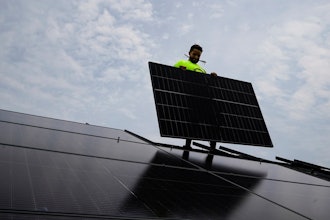
Bulldozers rumble up and down steaming mountains of wood chips 24 hours a day, stoking the boilers that provide electricity to all 168 square miles of Fort Drum, home of the Army's 10th Mountain Division.
The 60-megawatt biomass power plant is providing 100 percent of the electricity for the sprawling northern New York base starting this month. It's the first green energy project to come online since the Pentagon's 2012 commitment to developing 3 gigawatts of renewable energy — enough to power 750,000 homes — on Army, Navy and Air Force installations by 2025 as a way to help ensure the military's energy security.
"It's part of a comprehensive effort by the entire Army to improve our resiliency," Richard Kidd, deputy assistant secretary of the Army, said last month at a ceremonial signing of the project's 20-year, $289 million contract.
ReEnergy Holdings acquired the formerly coal-fired power plant at Fort Drum in 2011 and spent $34 million converting it to burn biomass — mostly chipped up branches, bark and other residues of timber operations in New York's North Country.
A $12 million project is also underway to connect the plant directly to the base's substations next summer. The Pentagon is pushing construction of independent power grids at military bases out of concern that utility companies are vulnerable to hackers, terrorists and natural disasters.
The Army has renewable energy projects at bases across the country. Three 30-megawatt photovoltaic solar arrays are under development at forts Stewart, Gordon and Benning in Georgia. Solar projects are also in the works at Redstone Arsenal in Alabama, Fort Huachuca in southern Arizona, Fort Detrick in Maryland, and Fort Irwin in California. Fort Hood in Texas recently launched a solar and wind energy project.
But a biomass plant like that at Fort Drum has the distinct advantage of providing year-round, 24-hour power, said Tony Marciniak, manager of the ReEnergy plant. Fort Drum uses about 28 megawatts of power a day, so ReEnergy will be able to sell excess power it generates.
The biomass facility has created nearly 200 jobs, including 34 full-time workers at the plant and dozens more in fuel supply, including additional timber company workers and truckers. It's a more labor-intensive business than the former coal plant, which received fuel by train and required stoking only once a day.
Marciniak said 80 to 100 tractor-trailers filled with wood chips arrive every weekday. The chips are kept in huge piles, where bulldozers continuously shove the fuel into a conveyor leading to the boilers inside.
"We're pumping upwards of $18 million annually into the local economy," Marciniak said.
Logging residue — mainly treetops and branches — makes up about 85 percent of the fuel mix at Fort Drum, said Larry Richardson, chief executive officer of Latham-based ReEnergy Holdings. Recovered wood from demolition projects makes up about 11 percent, and shredded tires make up the rest. The company is also collaborating with the State University of New York College of Environmental Science and Forestry to provide a market for shrub willow, an energy crop coming into production on about 500 acres in northern New York.
The advantages of biomass are that it's locally grown, renewable, and costs typically one-third less than fossil fuels. ReEnergy is certified by the Sustainable Forestry Initiative, an independent non-profit organization that verifies that the wood-chip fuel used at its nine plants in six states is procured from loggers who follow responsible land management practices.
"It was a significant investment on their part, to ensure all their harvests are done in a sustainable manner," said Eric Carlson of the Empire State Forest Products Association.
While critics have questioned the ethics of turning forests into fuel, Carlson said analysis by the U.S. Forest Service shows that New York could double its wood harvest and still not match the forest regeneration rate.
"Before ReEnergy opened we didn't have a market for this low-grade material," said Pat Curran of Seaway Timber Harvesting, largest supplier. "In most cases, it was staying on the forest floor."






















